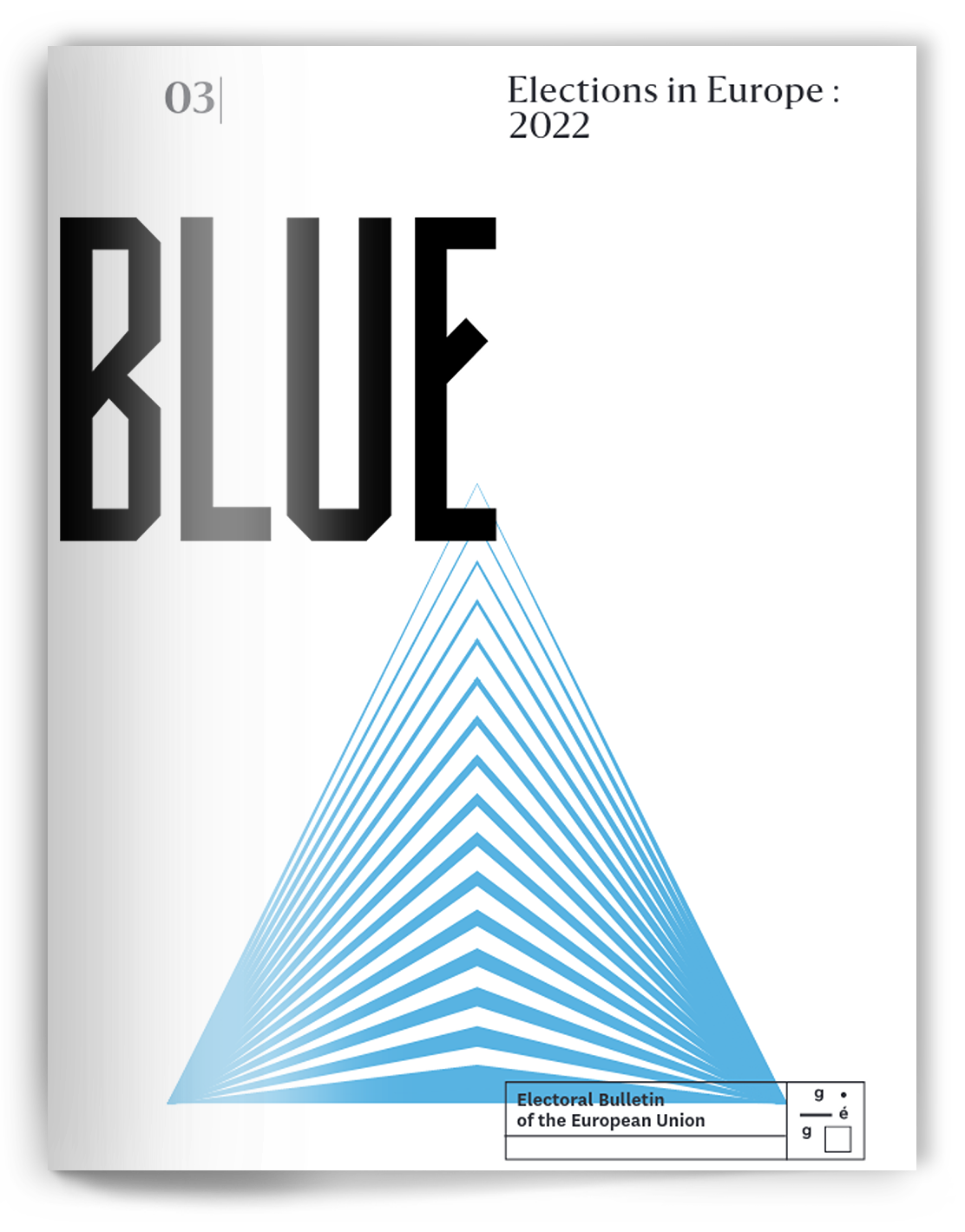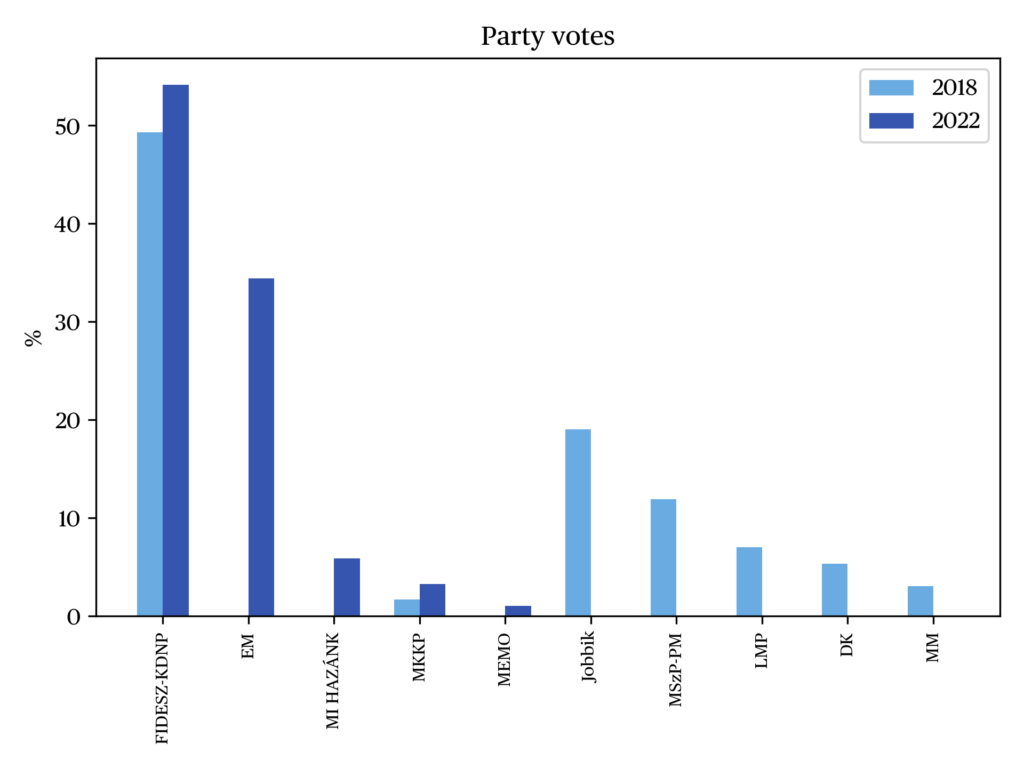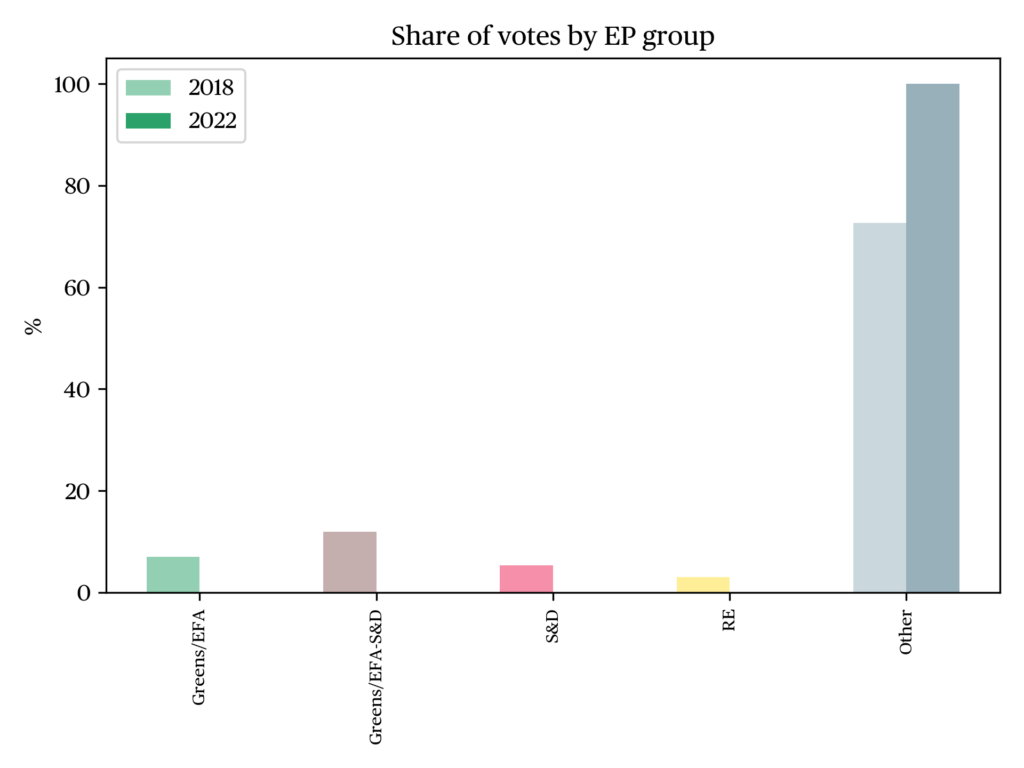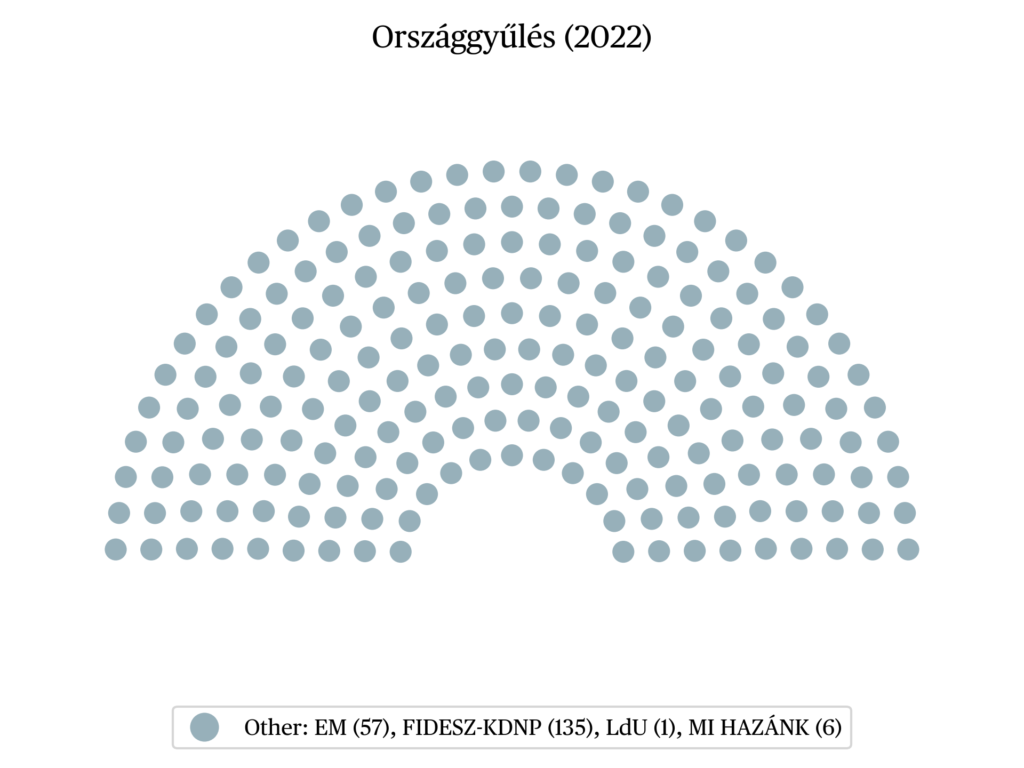Parliamentary election in Hungary, 3 April 2022
Eszter Farkas
PhD candidate in Political Science at Central European UniversityIssue
Issue #3Auteurs
Eszter Farkas
Issue 3, March 2023
Elections in Europe: 2022
The 2022 Hungarian national elections resulted in the rearrangement of the country’s party system. The governing party Fidesz was re-elected for the 4th time with an absolute majority
1
and thus re-occupied the central force position, the “central magnetic field,” whereas opposition parties remained ideologically diverse, fragmented, and rather weightless regarding their legitimacy and political representation. Moreover, a new far-right party (Mi Hazánk) exceeded the parliamentary threshold, and a small party (Párbeszéd) consolidated its position as a cartel party in the recent ten years.
Before the election, survey estimations were ambiguous: although most of the opinion polls showed that Fidesz will have more supporters on 3 April, the alliance of opposition parties has never seemed to be this close to possibly defeat the governing parties (Tóka 2022a). One reason for that were the primary elections held in October 2021, when opposition parties managed to organize a pre-selection among their members. Electoral rules require strong opposition candidates in single member districts, which dominates the allocation of seats. This cooperation and the establishment of a new democratic institution was clearly an innovation of the opposition alliance. During the weeks of the primary, the policy ideas of various opposition candidates were publicly discussed (due to the intensive work of an independent media outlet Partizán [Kováts 2022]), and thus they could dominate media discussions about politics in general. As a consequence, opinion polls pointed to a leading popularity of the opposition alliance against Fidesz for the first time since 2010. Because of the clear messages, the open discussion and declaration of political values, opposition supporters most probably considered them competent enough against Viktor Orbán. However, this innovation did not manage to sustain the opposition’s popularity: after the primaries, the intensity of the discussion drastically decreased, opposition voters were left in apathy, which was shown by the decreasing number of supporters in opinion polls as well (Tóka 2022b).
Election results signalized that the political/strategic cooperation among opposition parties alone will not bring political success. The Fidesz won most of the single member districts, whereas the party list of the opposition alliance also received only 34,44% of the votes, which is a huge disappointment, regarding the efforts that were put in the collaboration, and the expectations preceding the elections. Opinion bubbles in the polarized media system made opposition politicians believe that defeating Orbán was possible; in reality, an overall victory and strong legitimacy of the governing parties was achieved.
Comparing campaign strategies, the opposition alliance made serious mistakes during the electoral campaign. Although the strong anti-Orbán cleavage among voters and the obvious corruption issues of the current regime could have had its political benefits, the silent period (and long recovery) after the primaries, the public conflicts between collaborative members of the alliance discouraged opposition voters to appear on the election’s day. Furthermore, the imbalance between government and opposition’s political resources should be emphasized, too: the huge media dominance and almost infinite campaign resources of the governing parties has been creating unfair conditions since 2010.
To scrutinize the current situation and the newly (re)established party system in Hungary, I will elaborate on the political position of every related political actor: the governing parties, the opposition parties, and Mi Hazánk, as the new far-right party in the Hungarian parliament. Although the 2022 national election results — similarly to any elections — brought some significant alterations, the main phenomena have not changed since 2010: the political power and legitimacy of the government is unquestionable. Moreover, due to the imbalance of political resources, the biased electoral rules favoring Fidesz, and the incapability to form an ideologically homogeneous political group and suitable campaign strategy, the alliance of opposition parties failed again to gain enough political support from the voters.
Fidesz in the central magnetic field since 2010
The current European discourse considers the Hungarian prime minister Viktor Orbán as one of the most successful and powerful political leaders in Europe. This is not only because of the long time spent in government, but also because of the illiberal, authoritarian governing style that they exercise, and the anti-EU and pro-Russian rhetoric, which has been dominating Fidesz’s communication in the last decade (whereas the first Orbán government’s policies were clearly more centrist and pro-EU). Orbán and other significant politicians of Fidesz refer to their party and values as conservative christian-democratic, but — as suggested and elaborated by András Körösényi in his recent article — these are overweighted by the centralization of political institutions, radical political thoughts, the absence of rule of law, and the will of the people, as a crucial legitimizing factor in the sustention of power (Körösényi 2022). The referendum on the election day about the depiction of LGBTQ contents in schools similarly signalized these trends. In other terms, Orbán established the plebiscitary leader democracy in Hungary (Körösényi et al. 2020).
Therefore, the most important question of the 2022 Hungarian election was whether the 12 years reign of the Orbán-regime could be broken. If not, Orbán would gain enough power to continue the exclusive and chauvinistic politics he favours that privileges national sovereignty, hetoronormative families as the micro foundations of the society, and an unhealthy fiscal policy that harms mostly people on the bottom level of society and sustains a distorted allocation of economic resources (Mike 2022), where the decisive factor of wealth is the loyalty towards the government. This illiberal form of democracy, where the absolute majority of power belongs to a single party for longer than a decade, was first called the central magnetic field by Gábor Tóka, but the term was used by other government and opposition analysts as well (Urfi 2022), whereas some leading analysts of the government refer to the system as the “national block” instead of central magnetic field (Békés, 2022), whereas some radical opposition voices call it “controlled”, “Putin-style” democracy (Keller-Alánt 2022), where several human rights experts already signalized the threat under which the rule of law of Hungary is set.
Opposition parties: ideologically diverse, politically weak
One of the main purposes of politicians in the opposition alliance was to finally find the right candidate who can be an equal (or preferably stronger) opponent to Viktor Orbán in 2022. However, Péter Márki-Zay, the prime minister candidate of the opposition alliance did not manage to justify the trust of his voters in the primaries. As an openly christian, right-wing person with seven children and strong conservative views, the idea was that he would be able to convince rural people (where Fidesz is especially strong) to vote for him instead of Orbán. As a ‘newcomer’ in politics in 2018, he defeated Fidesz’s candidate in Hódmezővásárhely where Fidesz was outstandingly strong, and became the major there. Therefore, he was long considered to be able to mobilize undecided voters especially in rural areas. However, the extreme negative campaign of the government against Márki-Zay which messages were spread throughout the whole government media holding and some doubtful political statements of Márki-Zay made a successful campaign impossible.
For a long time, it was Gergely Karácsony, the mayor of Budapest, who seemed to possess this image in voters’ perceptions as a leader in waiting. But he backtracked from the second round of the primaries and supported Márki-Zay publicly against Klára Dobrev, the wife of the former prime minister Ferenc Gyurcsány. Since Gyurcsány was the main and most intensively demonized enemy figure of the Fidesz campaign, it was obvious that most opposition voters and politicians did not believe that she would be able to lead a successful political campaign against Orbán. As our election day poll research with Daniel Mikecz during the primaries showed, Dobrev was supported by older female voters, while higher educated, politically more interested and informed people voted for Márki-Zay (Farkas & Mikecz 2022).
Although currently represented values of parties in the opposition alliance became more or less homogenized at the end of the electoral campaign, clear policy messages and the perception of governing competence were missing from this political offer. The party of Gyurcsány, the Democratic Coalition, and the pro-European liberal Momentum Movement have been in most powerful positions in this alliance. The formerly successful and promising green party LMP has lost its electoral support in the European Parliamentary elections in 2019, and has not recovered since.
Párbeszéd (Dialogue) has a particular role in this political alliance. Since the foundation of the party in 2012, survey companies measure their popularity at 1-2%, whereas its politicians have been possessing significant decision making authority in various political positions. The number of these positions is clearly disproportionate to the popularity of the party. One of the main declared purposes of Párbeszéd’s founders (one of the mayor Gergely Karácsony) was to initiate cooperation among opposition parties, because they declared this as the only way to accommodate current electoral rules and defeat the Orbán-regime. Thus, Párbeszéd’s politicians became one of the main engines of opposition alliances, which launched a common party list already for the 2014 national elections against Fidesz. Although every election more and more opposition parties joined this alliance, the lack of integrated political program and any decisive, substantive (counter)narratives against Fidesz’s political messages hindered the victory of this political formation. The 2019 municipal elections were the only exception where opposition politicians ran surprisingly well: not only the mayor position, but several other districts and seats were won by opposition parties, among them many politicians of Párbeszéd succeeded. According to their website, they have the mayor, one district mayor, 6 deputy mayors, five members in the parliament, and twelve representatives in various districts and municipalities as elected politicians.
Therefore, we can claim that the party has become a cartel party in the recent decade, according to the related definitions of political sciences. As Katz and Mair point out in their study in 1995, “Cartel parties are the entanglement of party and state, and the established norm of inter-party collaborations. (…) Related dynamics are dependent on the collaborations and cooperation with other political forces, and these collaborations require the contributions of every or almost every other political actor.” (Katz & Mair, 1995). Consequently, there is a particularistic (and in the Hungarian context unique) situation when the institutional representation and the available state and political resources of a party is (and has always been) much stronger than its electoral support.
The re-birth of the far-right in Hungary
With 5.88% of party list votes, the extremely radical right-wing Mi Hazánk managed to reach the parliamentary threshold for the first time in their history. The party is the successor of the previously far-right, now consolidated “people’s party” Jobbik, or in other words, extreme politicians who left Jobbik founded Mi Hazánk to represent a clearly radical position on the immigration and refugee issue, on the problems of roma people, the coronavirus crisis or the war in Ukraine. Since the decade-long xenophobic rhetoric of Fidesz and the constantly applied “moral panic button” strategy by governing parties (Gerő & Sik 2020), right-wing feelings in the Hungarian society could be preserved, and Mi Hazánk could serve as the shelter of those voters who identify with these thoughts. Official statements after the elections confirmed that Mi Hazánk spent the most amount of money on campaigning in 2022, so the party possessed enough resources to run successfully. Some opinion polls measured the party as the largest opposition force after the elections.
The stable reign of Fidesz and the expansion of Mi Hazánk means a significant loss for Jobbik primarily. Although Jobbik was clearly a far-right party in 2009, after some unsuccessful elections the party has been starting to frame itself as a mainstream conservative “people’s party;” as suggested before, politicians who did not agree with this political direction were founders of Mi Hazánk. Thus, the question of how much the rate of far-right minded people in Hungary increased, is difficult to answer. Clearly, most voters of Mi Hazánk might belong to this category. Parallel with the national elections, a referendum about LMBTQ rights was held, which mobilized and significantly intensified homophobic attitudes in the Hungarian society.
To conclude: the decade of consolidation
The not so surprising conclusion of my analysis is that the Hungarian party system did not change but consolidated during the recent decade. Orbán and Fidesz have an absolute majority in the Hungarian national parliament, whereas opposition parties suffered a significant defeat and still continue the inter-party conflicts that have been dominating their political activity for a while now. Moreover, the far-right party Mi Hazánk woke the partly latent, extremely xenophobic and homophobic attitudes, of which consequences on Hungarian laws and policies are unclear yet.
Whether current opposition parties will be ever able to defeat Orbán remains a question, while several analysts of opposition parties seem more and more pessimistic (Bojar et al., 2022). In fact, as pointed out in another article by Dániel Róna (2022), instead of blurred values and identity politics, the level of education seems to be decisive among voters. Those who are uneducated are the least likely to vote, or they are the easiest to convince by the government. Therefore, opposition parties and politicians should start to primarily concentrate on these facts, rather than any “meta versions” of politics. Although the war in Ukraine, the economic recession, inflation and the possibly increasing of coronavirus cases might create a more uncertain political environment for Orbán in the EU opposition politicians should prove their political competences as well, and not to be remembered as those who were never able to provide an appropriate alternative against Orbán’s political regime.
References
Aradi Hanga, Zs. (2022). Medián: A Mi Hazánk a legerősebb ellenzéki párt). Online. Retrieved 11.7.22.
Békés, M. (2022). Centrális erőtér helyett nemzeti blokk). Online. Retrieved 11.7.22.
Bojar, A., Gáspár, Z. & Róna, D. (2022). Can they ever win? The past and future prospects for an opposition victory in Hungary’s competitive authoritarian regime. Online. Retrieved 11.7.22.
Farkas, E. & Mikecz, D. (2022). Fővárosi, személyesen szavazó előválasztók szociológiai, politikai háttere. Online. Retrieved 11.7.22.
Farkas, Gy. (2022). A Mi Hazánk többet költött a választásra, mint a Jobbik, az MSZP és az LMP együtt. Online. Retrieved 11.7.22.
Gerő, M., & Sik, E. (2020). The Moral Panic Button 1: Construction and Consequences. In Europe and the Refugee Response. Routledge: 39-58.
Katz, R. S., & Mair, P. (1995). Changing models of party organization and party democracy: the emergence of the cartel party. Party politics, 1(1): 5-28.
Keller-Alánt, Á. (2022). Nem a centrális erőtér tért vissza, putyini, irányított demokrácia jöhet. Online. Retrieved 11.7.22.
Körösényi, A., Illés, G., & Gyulai, A. (2020). The Orbán regime: Plebiscitary leader democracy in the making. Routledge.
Körösényi, A. (2022). A NER-elit szemébe mondta: nem vagytok konzervatívok – itt a Körösényi-beszéd teljes szövege! Online. Retrieved 11.7.22.
Kováts, E. (2022). Den marginalisierten eine Stimme geben). Online. Retrieved 11.7.22.
Mike, K. (2022). Így verd át a népet! – a fiskális illúziókeltés 7 pontja cinikus kormányok számára. Online. Retrieved 11.7.22.
Róna, D. (2022). A populizmus hiánya. Online. Retrieved 11.7.22.
Urfi, P. (2022). Helyreáll a centrális erőtér a parlamentben, mondják a fideszes elemzők. Online. Retrieved 11.7.22.
Tóka, G. (2022a). Másfél év mozdulatlanság – parlamenti választási esélyek a starvonalnál. Online. Retrieved 11.7.22.
Tóka, G. (2022b). Közvélemény-kutatási összefoglaló, 2022. április 3. Online. Retrieved 11.7.22.
Notes
- Fidesz gained 54.3% of party list votes and 67.84% of parliamentary seats. The alliance of opposition parties (DK, Jobbik, LMP, Momentum, Párbeszéd) received 34.44% of party list votes and 28.64% of parliamentary seats. Mi Hazánk received 5,88% of party list votes and possesses now 3.02% of parliamentary seats. However, the electoral system favors those who can win most of the first-past-the-post single vote districts – in which the governing party has absolute dominance since 2010, too. Source: National Election Office.
citer l'article
Eszter Farkas, Parliamentary election in Hungary, 3 April 2022, Oct 2022,
à lire dans cette issue
voir toute la revue









